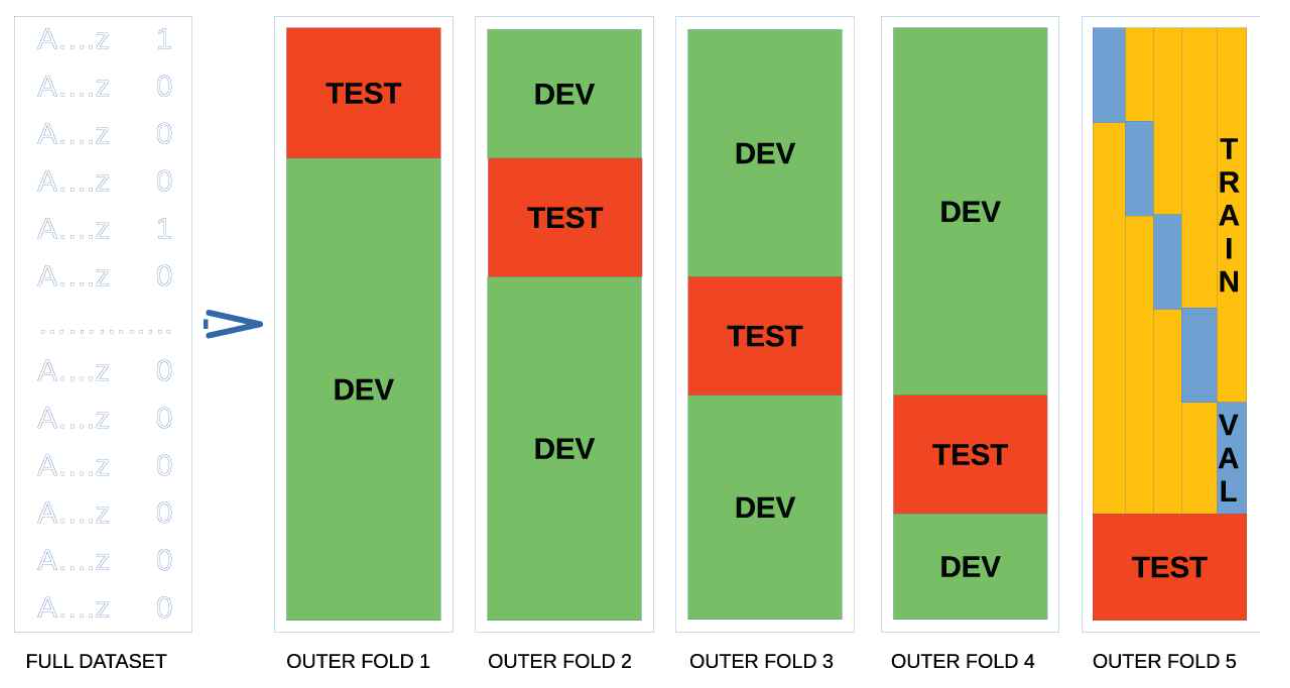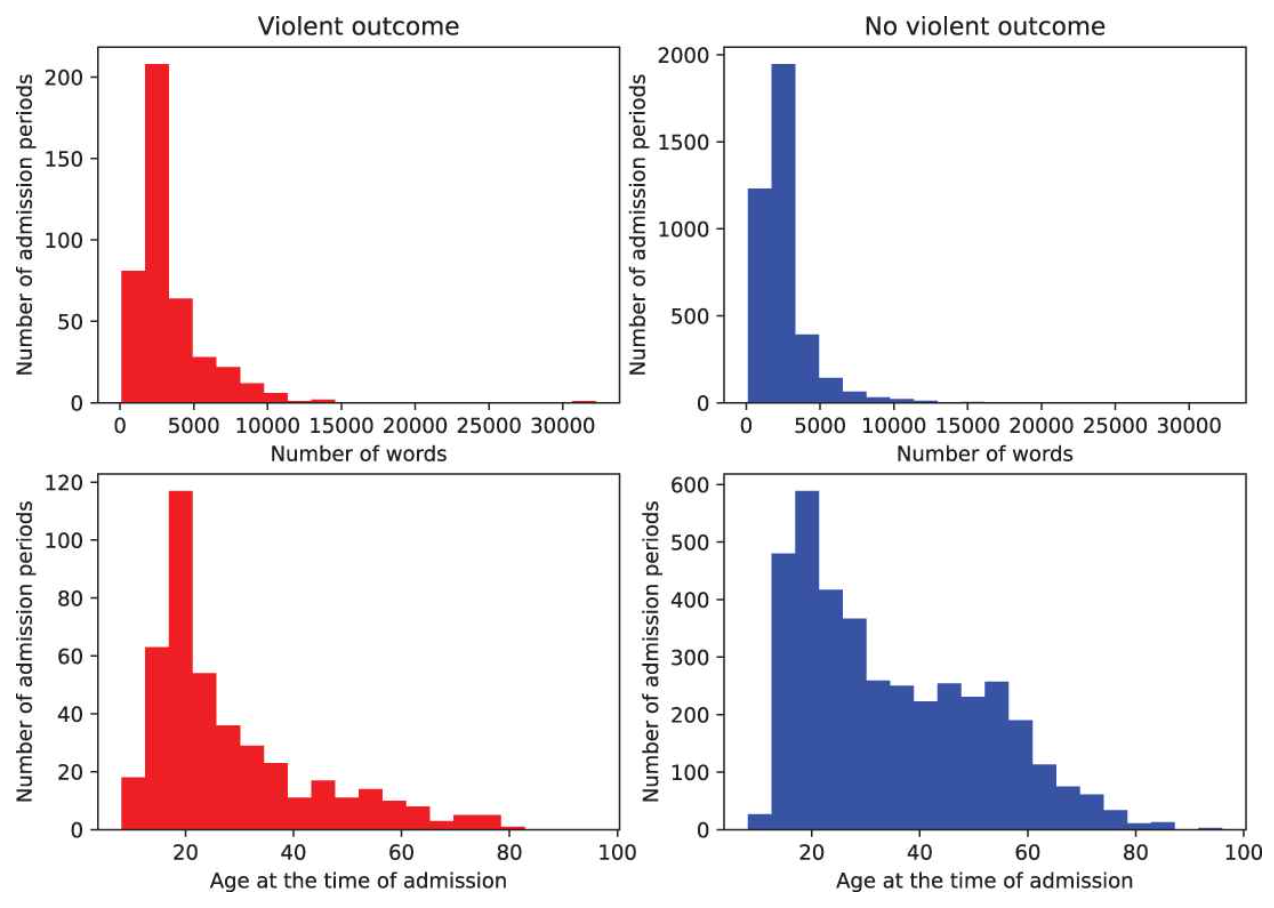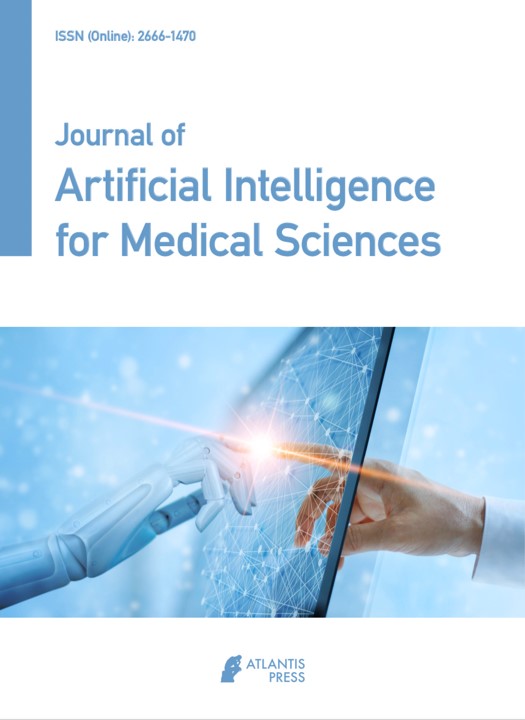博文
文章荐读-JIAMS | 使用荷兰临床笔记进行暴力风险评估的机器学习技术
||
小编导读
精神病院的暴力风险评估可以帮助医护人员采取干预措施,从而避免暴力事件。由执业医师撰写的临床笔记和电子健康记录是获取独特信息的宝贵资源,但很少被充分利用。来自荷兰Utrecht University、 Eindhoven University of Technology、University Medical Center Utrecht、Leiden University Medical Center、 Leiden Institute of Advanced Computer Science 的学者们在期刊Journal of Artificial Intelligence of Medical Sciences(eISSN 2666-1470)上发表了题为“Machine Learning for Violence Risk Assessment Using Dutch Clinical Notes”的文章,研究了利用医生临床记录进行评估精神病患者暴力风险的机器学习方法。
要点介绍
在荷兰临床精神病学机构工作的约三分之二的精神卫生专业人员报告说,他们的职业生涯中至少经历过一次身体暴力事件。这些事件会对从业者产生强烈的心理影响,也会给卫生机构带来经济损失。目前,已经有研究提出了多种暴力风险评估(VRA)方法来预测和避免暴力事件,并且应用到了实践中。传统上,常用的方法是Brøset暴力检查表(BVC),即护士和精神病医生使用问卷调查来评估患者卷入暴力事件的可能性。但填写表格是一个耗时且高度主观的过程。
机器学习方法则可以通过节省时间和使预测更加准确来改进这一过程。电子健康记录(EHR)是一个包含结构化字段和书面笔记的丰富信息源。EHR笔记结合暴力事件报告可以用来训练机器学习模型,将笔记分类为描述潜在暴力患者的笔记。
在本研究中,我们重点探讨使用医生临床笔记进行精神病患者暴力风险评估的机器学习方法。我们发现深度学习模型BERTje的表现比传统的机器学习方法差。此外,我们还评估了实验数据和分类器,以更好地了解实验模型的性能。

图1. 用于超参数调整和统计不确定性估计的数据处理管道的示意图

图3. Kappa曲线为我们的支持向量机(SVM)分类器的外部交叉验证循环的迭代之一。该图中的最大值可以解释为分类器的最佳工作点。对于所有假阳性率,随机猜测结果Cohen's kappa等于0。

图4. 阳性/暴力(左/红色)和阴性/非暴力(右/蓝色)入院期的每个周期的字数直方图注释(顶部)和入院期开始时的年龄(底部)。
研究结论:我们使用荷兰乌得勒支UMC精神病学病房的荷兰语临床笔记,将传统和深度机器学习方法应用于VRA问题。与传统的机器学习方法相比,我们发现使用BERTje并没有改善;事实上,BERTje的结果更差,AUC≈0.66。原因可能是我们使用的数据集很小,不足以微调BERTje中存在的大量参数。为了扩大数据集,来自多个机构的数据可以通过联合学习进行聚合,不同机构训练相同的中心模型,而不相互共享数据;考虑到隐私限制,这一点非常重要。此外,使用来自不同医学领域的荷兰临床笔记,预先培训“医学BERTje”模型将非常有益。最后,我们工作中的一个关键假设是,未报告的暴力事件数量很少。这个假设的有效性需要仔细检查。需要进一步的工作来完善从临床笔记中选择未报告事件的过程。这也有助于在实践中重新评估暴力事件报告。我们已经看到,从业者在报告暴力事件时可能非常主观。采用机器学习的统一事件报告策略可以显著提高数据质量。
参考文献 References
[1] M. van Leeuwen, J. Harte, Violence against mental health care professionals: prevalence, nature and consequences, J. Forensic Psychiatry Psychol. 28 (2017), 581–598.
[2] M.Inoue,K.Tsukano,M.Muraoka,F.Kaneko,H.Okamura,Psy- chological impact of verbal abuse and violence by patients on nurses working in psychiatric departments, Psychiatry Clin. Neu- rosci. 60 (2006), 29–36.
[3] H. Nijman, L. Bowers, N. Oud, G. Jansen, Psychiatric nurses’ experiences with inpatient aggression, Aggress. Behav. 31 (2005), 217–227.
[4] J.P. Singh, S.L. Desmarais, C. Hurducas, K. Arbach-Lucioni, C. Condemarin, K. Dean, et al., International perspectives on the practical application of violence risk assessment: a global survey of 44 countries, Int. J. Forensic Ment. Health. 13 (2014), 193–206.
[5] R. Almvik, P. Woods, K. Rasmussen, The Brøset violence check- list: sensitivity, specificity, and interrater reliability, J. Interpers. Violence. 15 (2000), 1284–1296.
[6] C.Y. Chen, P.H. Lee, V.M. Castro, J. Minnier, A.W. Charney, E.A. Stahl, et al., Genetic validation of bipolar disorder identified by automated phenotyping using electronic health records, Transl. Psychiatry. 8 (2018), 1–8.
[7] C.Colling,M.Khondoker,R.Patel,M.Fok,R.Harland,M.Broad- bent, et al., Predicting high-cost care in a mental health setting, BJPsych Open. 6 (2020), E10.
[8] R. Perlis, D. Iosifescu, V. Castro, S. Murphy, V. Gainer, J. Minnier, et al., Using electronic medical records to enable large- scale studies in psychiatry: treatment resistant depression as a model, Psychol. Med. 42 (2012), 41–50.
[9] G. Gorrell, S. Oduola, A. Roberts, T. Craig, C. Morgan, R. Stewart, Identifying first episodes of psychosis in psychiatric patient records using machine learning, in Proceedings of the 15th Workshop on Biomedical Natural Language Processing, ACL, Berlin, Germany, 2016, pp. 196–205.
[10] K.J. Moon, Y. Jin, T. Jin, S.M. Lee, Development and validation of an automated delirium risk assessment system (auto-delras) implemented in the electronic health record system, Int. J. Nurs. Stud. 77 (2018), 46–53.
[11] V. Menger, F. Scheepers, M. Spruit, Comparing deep learning and classical machine learning approaches for predicting inpa- tient violence incidents from clinical text, Appl. Sci. 8 (2018), 981.
[12] V. Menger, M. Spruit, R. van Est, E. Nap, F. Scheepers, Machine learning approach to inpatient violence risk assessment using rou- tinely collected clinical notes in electronic health records, JAMA Netw. Open. 2 (2019), e196709.
[13] P. Mosteiro, E. Rijcken, K. Zervanou, U. Kaymak, F. Scheepers, M. Spruit, Making sense of violence risk predictions using clin- ical notes, in: Z. Huang, S. Siuly, H. Wang, R. Zhou, Y. Zhang (Eds.), Health Information Science, Springer International Pub- lishing, Cham, Switzerland, 2020, pp. 3–14.
[14] J. Devlin, M.W. Chang, K. Lee, K. Toutanova, BERT: pre-training of deep bidirectional transformers for language understanding, in Proceedings of the 2019 Conference of the North American Chap- ter of the Association for Computational Linguistics: Human Lan- guage Technologies, Minneapolis, MN, USA, 2019, vol. 1, pp. 4171–4186.
[15] A.J. Quijano, S. Nguyen, J. Ordonez, Grid search hyperparameter benchmarking of BERT, ALBERT, and LongFormer on DuoRC, arXiv:2101.06326 [Preprint], 2021, p. 9. https://arxiv.org/abs/ 2101.06326
[16] Y. Cui, W. Che, T. Liu, B. Qin, S. Wang, G. Hu, Revisiting pretrained models for Chinese natural language processing, in EMNLP 2020: Findings of the Association for Computational Linguistics, ACL, 2020, pp. 657–668.
[17] N. Vaci, Q. Liu, A. Kormilitzin, F. De Crescenzo, A. Kurtulmus, J. Harvey, et al., Natural language processing for structuring clin- ical text data on depression using UK-CRIS, Evid. Based Ment. Health. 23 (2020), 21–26.
[18] M. Senior, M. Burghart, R. Yu, A. Kormilitzin, Q. Liu, N. Vaci,et al., Identifying predictors of suicide in severe mental illness: a feasibility study of a clinical prediction rule, Front. Psychiatry. 11 (2020), 268.
[19] R. Rijo, R. Martinho, L. Pereira, C. Silva, Text mining applied to electronic medical records, Int. J. E-Health Med. Commun. 6 (2015), 1–18.
[20] Y. Wang, L. Wang, M. Rastegar-Mojarad, S. Moon, F. Shen, N. Afzal, et al., Clinical information extraction applications: alit- erature review, J. Biomed. Inform. 77 (2018), 34–49.
[21] S. Friedman, R. Margolis, O.J. David, M. Kesselman, Predicting psychiatric admission from an emergency room, J. Nerv. Ment. Dis. 171 (1983), 155–158.
[22] J.S. Lyons, J. Stutesman, J. Neme, J.T. Vessey, M.T. O’Mahoney, H.J. Camper, Predicting psychiatric emergency admissions and hospital outcome, Med. Care. 35 (1997), 792–800.
[23] B.L. Cook, A.M. Progovac, P. Chen, B. Mullin, S. Hou, E. Baca-Garcia, Novel use of Natural Language Processing (NLP) to predict suicidal ideation and psychiatric symptoms in a text- based mental health intervention in Madrid, Comput. Math. Methods Med. 2016 (2016), 8708434.
[24] S.H. Huang, P. Le Pendu, S. VIyer, M. Tai-Seale, D. Carrell, N.H. Shah, Toward person-alizing treatment for depression: pre- dicting diagnosis and severity, JAMIA. 21 (2014), 1069–1075.
[25] D. Van Le, J. Montgomery, K.C. Kirkby, J. Scanlan, Risk predic- tion using natural language processing of electronic mental health records in an inpatient forensic psychiatry setting, J. Biomed. Inform. 86 (2018), 49–58.
[26] T. Mikolov, K. Chen, G. Corrado, J. Dean, Efficient estimation of word representations in vector space, in 1st International Confer- ence on Learning Representations, Workshop Track Proceedings (ICLR 2013), Scottsdale, AZ, USA, 2013.
[27] Q. Le, T. Mikolov, Distributed representations of sentences and documents, PMLR. 32 (2014), 1188–1196.
[28] A. Rumshisky, M. Ghassemi, T, Naumann, P. Szolovits, V.M. Castro, T.H. McCoy, R.H. Perlis, Predicting early psychi- atric readmission with natural language processing of narrative discharge summaries, Transl. Psychiatry. 6 (2016), e921.
[29] T. Fawcett, An introduction to ROC analysis, Pattern Recognit. Lett. 27 (2006), 861–874.
[30] J. Huang, C.X. Ling, Using AUC and accuracy in evaluating learn- ing algorithms, IEEE Trans. Knowl. Data Eng. 17 (2005), 299–310.
[31] M. Sokolova, G. Lapalme, A systematic analysis of performance measures for classification tasks, Inf. Process. Manag. 45 (2009), 427–437.
[32] U. Kaymak, A. Ben-David, R. Potharst, The AUK: a simple alternative to the AUC, Eng. Appl. Artif. Intell. 25 (2012), 1082–1089.
[33] J. Cohen, A coefficient of agreement for nominal scales, Educ. Psychol. Meas. 20 (1960), 37–46.
[34] V. Menger, F. Scheepers, L. van Wijk, M. Spruit, DEDUCE: a pattern matching method for automatic de-identification of dutch medical text, Telemat. Inform. 35 (2018), 727–736.
[35] S. Bird, E. Klein, E. Loper, Natural language processing with python: analyzing text with the natural language toolkit. 2019. https://www.nltk.org/book/
[36] R. Řehůřek, P. Sojka, Software framework for topic modelling with large corpora, in Proceedings of LREC 2010 Workshop on New Challenges for NLP Frameworks, University of Malta, Val- letta, Malta, pp. 45–50.
[37] S. Syed, M.R. Spruit, Full-text or abstract? Examining topic coher- ence scores using latent dirichlet allocation, in 2017 IEEE Inter- national Conference on Data Science and Advanced Analytics (DSAA), Tokyo, Japan, pp. 165–174.
[38] C. Cortes, V. Vapnik, Support-vector networks, Mach. Learn. 20 (1995), 273–297.
[39] L. Breiman, Random forests, Mach. Learn. 45 (2001), 5–32.
[40] T. Wolf, L. Debut, V. Sanh, J. Chaumond, C. Delangue, A. Moi,et al., Transformers: state-of-the-art natural language processing, in Proceedings of the 2020 Conference on Empirical Methods in Natural Language Processing: System Demonstrations, ACL, 2020, pp. 38–45.
[41] Google Research, Multilingual BERT [repository], 2019. https:// github.com/google-research/bert/blob/master/multilingual.md
[42] W. de Vries, A. van Cranenburgh, A. Bisazza, T. Caselli, G. van Noord, M. Nissim, BERTje: a Dutch BERT model. 2019. https://arxiv.org/abs/1912.09582
[43] B. van der Burgh, S. Verberne, The merits of universal lan- guage model fine-tuning for small datasets - a case with Dutch book reviews, arXiv:1910.00896 [Preprint], 2019. https://arxiv.org/abs/1910.00896
[44] L. Joosten, Sentiment Analysis of Dutch Tweets: a Comparison of Automatic and Manual Sentiment Analysis, Bachelor’s Disserta- tion, Utrecht University, Utrecht, The Netherlands, 2015.
[45] L. Yang, M. Zhang, C. Li, M. Bendersky, M. Najork, Beyond 512 tokens: Siamese multi-depth transformer-based hierarchical encoder for long-form document matching, in Proceedings of the 29th ACM International Conference on Information & Knowledge Management, 2020, pp. 1725–1734.
[46] R. Suchting, C.E. Green, S.M. Glazier, S.D. Lane, A data science approach to predicting patient aggressive events in a psychiatric hospital, Psychiatry Res. 268 (2018), 217–222.
原文信息
P. Mosteiro , E. Rijcken, K. Zervanou, U. Kaymak, F. Scheepers, M. Spruit, "Machine Learning for Violence Risk Assessment Using Dutch Clinical Notes", Journal of Artificial Intelligence for Medical Sciences, 2021, DOI: 10.2991/jaims.d.210225.001.

扫描二维码,获取英文原文
关于期刊

Journal of Artificial Intelligence of Medical Sciences (JAIMS,eISSN 2666-1470)是一本国际性的、经过严格同行评审的开放存取期刊,刊载人工智能在医学、医疗保健和生命科学所有交叉学科方向的理论,方法和应用的研究。编辑团队尤其欢迎在机器/深度学习、数据科学、自然语言处理(NLP)等支持下,为医学诊断、药物开发、护理、精准治疗等领域提供最近见解的原创性研究文章、综合评论、通信和观点。
JAIMS 由荷兰阿姆斯特丹自由大学黄智生教授担任创刊主编,来自八个国家的36名领域一流学者担任首届编委会,致力于将期刊打造为医学人工智能领域的首选阵地和开放科学平台。文章成果版权作者保留,不收取任何费用。欢迎各位专家投稿!
版权声明:
*本文内容由Atlantis Press中国办公室编辑。欢迎转发。如需转载,请在留言区留言,或联系xin.guo@atlantis-press.com。
![]()
Atlantis Press是科学、技术和医学(STM)领域的全球开放获取出版品牌,2006年创立于法国巴黎,在巴黎、阿姆斯特丹、北京、郑州和香港设有办事处。我们的使命是通过促进科研界和整个社会更有效地传播和交流知识来支持科学、技术和医学研究的进步。迄今,Atlantis Press的数字内容平台包含超过14万篇开放获取论文供读者免费下载阅读,每年产生2500多万下载量。Atlantis Press是施普林格·自然的一部分。
https://wap.sciencenet.cn/blog-3453320-1282135.html
上一篇:这场多届国际会议首次线上召开,还设有最佳论文奖和奖金,欢迎关注
下一篇:文章荐读 | 基于深度核学习的贝叶斯深度强化学习